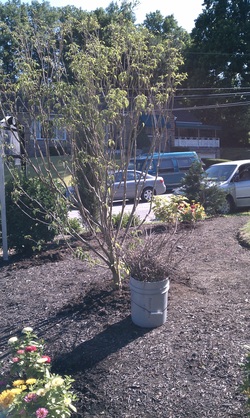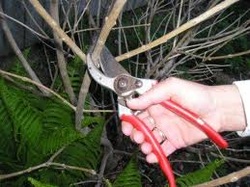 When we purchased the very large specimens of 'Milky Way' from Chapon's for the Collins corners, we knew they were stock from the previous season, and as a result, were stressed, but we figured we could baby them back to health. Towards that end, we have been regularly supplementing their water with rooting hormone, we have given them some nice compost, and some excellent organic fertilizer. When Mother Nature doesn't provide the water, volunteers from the garden club do. It's almost July and it's a dry day--a perfect time to prune woody plants like our little dogwoods. I went at them today, a little more conservatively than I would have if they had not been stressed. In other words, there are a few crossing branches and shoots from the base of the tree that I would have removed if I didn't want to preserve every leaf to do their important job of photosynthesis. I only removed dead or damaged wood, and opened up the center a little bit. I also found some long-dead ivy tendrils that were still strangling some of the upper branches, and removed all of those. You can see from the bucket in the snapshot; 'Milky Way' is a twiggy bugger, so it took quite a while to work my way through those tiny twigs. (In Girl Scout parlance, it's all tinder, and no kindling or fuel.) Normally, I find pruning to be a very soothing experience--a perfectly literal decision tree from start to finish. I was feeling very Zen for the first couple of hours, and then I came to two conclusions: 1. My pruner is garbage, and I need a new one today. 2. I should have eaten breakfast before I started this project.
0 Comments
There isn’t a common answer to the common question, “When should I prune my hydrangea?” because there are numerous species of hydrangea. Among the most popular types in our area are:
Hydrangea macrophylla (bigleaf hydrangea) is sometimes easy to recognize because its flower color changes with the soil pH: blue in acid soil; pink in alkaline. The leaves are coarsely serrated and glossy, dark green. H. macrophylla also include the lacecap hydrangeas, whose flowers look like a circle of unopened buds surrounded by open petals. Bigleaf type hydrangea set their flower buds during late summer to early fall (i.e., bloom on old wood.) Pruning bigleaf hydrangea in the spring or even late fall, after the buds have been set, will remove the flower buds and any chance of getting flowers that season. Bigleaf hydrangea should be pruned as soon as the flowers have faded in the summer. There are also newer remontant cultivars of H. macrophylla such as ‘Endless Summer’, which bloom on both old and new wood. This means that if the old growth is damaged by late spring frosts or by spring pruning, you will still get flowers on the new growth during the summer. Hydrangea arborescens (smooth hydrangea or sevenbark) cultivars, including ‘Annabelle’ and Hydrangea paniculata (hydrangea or hortensia) cultivars,including 'Pee Gee',have (usually white) flowers which are set only on new growth. They can be cut back immediately after flowering and may rebloom or they can be cut back in late winter or very early spring and still be expected to flower the following season. How far you cut them back is based on personal preference. You can choose not to prune H. arborescens or H. paniculata at all, but pruning makes for a neater plant and, if you want long stems for fresh or dried flowers, pruning back hard encourages long stems on older plants. Hydrangea quercifolia (oakleaf hydrangea) is a native plant characterized by its oakleaf-shaped foliage. Oakleaf hydrangea blooms on new wood and can be pruned in late winter or early spring, while dormant, to remove dead wood. If it has experienced winter dieback, prune back to below the point of injury. Hydrangea anomala petiolaris (climbing hydrangea) is a vine, not a shrub, and requires little to no pruning. Once climbing hydrangeas become established, they can grow quite vigorously and may only need occasional summer pruning to stay in bounds. Isn’t now a great time for a quick review of pruning principles? As I type this, we literally can’t get into our gardens to do anything else, so let’s observe the structure of our woody ornamentals. Early March is a good time to make the sometimes-difficult decision to remove trees that have been weakened and disfigured by topping, and to plan proper pruning of our shrubs and trees.
The late dormant season in our area—late winter, before bud break—is the optimal time of year to prune summer-blooming ornamental shrubs and trees, as well as shade trees. The second best time is the middle of summer. Do not wait until the spring flush of growth to prune, and don’t prune in autumn. A rule of thumb to follow is not to prune when leaves are forming or falling. Of course, if you have a branch that is dead, diseased, or dangerous, it may be removed at any time. Hand pruning shears, loppers, or saws are recommended for pruning; hedge shears are not. Late winter is not the time to prune spring-blooming woody plants, because the flower buds of spring-bloomers, like rhododendrons, azaleas (both of which normally require little pruning), and lilacs, are set in the previous growing season; in other words, these plants bloom on old wood. The better time to prune them is directly after they finish blooming, if you want to preserve this year’s show. However, it is desirable to winter-prune spring-bloomers that have become straggly through long neglect. Cut long branches to encourage new bud development early in the next growing season. If such pruning is postponed until summer, dormant buds already present may remain so until the following spring when several will break near each pruning wound. In the interim, the plant will appear unattractive. To thin out most deciduous shrubs and trees, cut off a branch or twig at its point of origin from the parent stem, or to a lateral side branch, to the Y of a branch junction, or at ground level. Never simply shear the ends of branches off, and never top trees. To rejuvenate an old, overgrown shrub, remove one-third of the oldest, tallest branches at or slightly above ground level. Proper pruning practices will preserve the natural shape of the plant, will protect it from many pathogens, and will promote vigorous growth of the plant. It’s winter in Blackridge, and most of our large trees are bare of leaves, so we can observe the branching structure, and plan appropriate pruning, which is best done in late winter or very early spring, before bud break. Winter is a good time to make the decision to carefully remove trees that have been weakened and disfigured by topping (aka “stubbing” or “heading”), and especially trees on which you can see fungal conks (aka “shelves” or “brackets”), indicating the tree is rotted and in danger of falling. (And I have seen a few of those in Blackridge.)
On the other hand, short of these extreme circumstances, or if a tree is dying, in a dangerous spot, or causing significant property damage, I am very hesitant to ever recommend removal of mature trees, and would recommend that you first consider the financial value of large shade trees, in addition to their dominant position in the micro-climates and ecosystems in your Blackridge yards. We are lucky to have so many mature trees in our neighborhood, helping to give it its special character. There are actual formulae in use to calculate the value of a large tree based on its size, species, condition, and location; estimates generally show a 10-20% increase in the value of your property, depending on these criteria. Shade trees, both deciduous and evergreen, help cool our homes and neighborhood in the summer; serve to break the cold winds, especially from the northwest, to help lower heating costs in the winter; and provide habitat and food above and below ground for beneficial birds, insects, and other organisms—not to mention the other plants in your landscape—or yourselves. If a mature tree must be removed, a certified arborist should be consulted and a thoughtfully-selected replacement tree should be planted. (Check a future blog post for a list of a few of my favorite shade trees.) Here are some of the things I like to do at this time of year:
1. Mulch overwintering root crops, such as carrots or parsnips with clean straw. The bales you used for your Halloween decorations are perfect for this use. 2. If moles and mice are prevalent, place your tulip bulbs in wire “cages” as you plant them. 3. Get a head start on spring weeding by clearing as many weeds as possible from your beds now. 4. Mulch your bramble fruits as they go dormant. (I’ll also be giving winter protection to my new ‘Chicago Hardy’ fig.) 5. Keep watering perennials and newly planted shrubs and trees until the ground freezes. 6. Take soil samples for testing before the ground freezes--usually by mid-November. (Especially from areas where crops didn’t do well.) 7. Mulch trees, shrubs, roses, and perennials once the ground has frozen. 8. Begin winter pruning only when trees are thoroughly dormant. I found nice comprehensive lists of November and December monthly garden chores at: http://awaytogarden.com. If you have any other seasonal tips you’d like to share, let us know. |
Author,
|
Copyright © 2020. All web site design, text, graphics, the selection and arrangement thereof, and all software are Copyright protected under the copyright laws. Any use of materials on this website, including reproduction, modification, distribution or republication, without the prior written consent of Blackridge Garden Club, is strictly prohibited.

 RSS Feed
RSS Feed